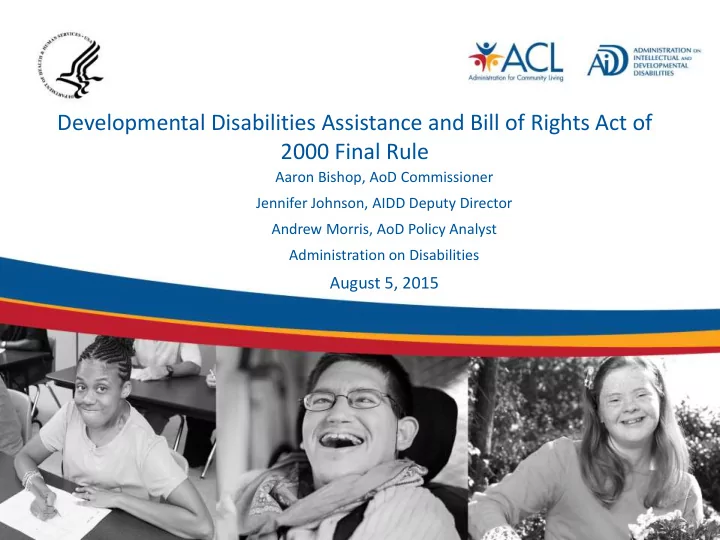

Developmental Disabilities Assistance and Bill of Rights Act of 2000 Final Rule Aaron Bishop, AoD Commissioner Jennifer Johnson, AIDD Deputy Director Andrew Morris, AoD Policy Analyst Administration on Disabilities August 5, 2015
Background • The DD Act was reauthorized in 2000. • The programs/networks authorized under the legislation include: – State Councils on Developmental Disabilities – Protection & Advocacy Systems – University Centers for Excellence in Developmental Disabilities • Projects of National Significance are also authorized – Projects of National Significance are not significantly impacted as a result of this rule.
Protection & Advocacy Systems • The final rule clarifies access to records and access to individuals. – P&As investigating abuse and neglect must often devote significant time and money to access individuals and records authorized by statute. – The final rule details when consent is required for a P&A to gain access to either records or an individual receiving services. – The final rule details the relationship of P&As to HIPPA, Peer Review Records, and FERPA. – The final rule addresses court decisions impacting the DD Act since its last reauthorization.
Protection & Advocacy Systems • Based on stakeholder comments, the rule seeks to bring the PADD program into alignment with other federal P&A programs to the extent possible. • The rule also addresses items such as: – Confidentiality of records – Probable cause – Reporting requirements of service providers to P&As after the death of an individual with developmental disability – Reporting requirements for P&As
State Councils on Developmental Disabilities • The final rule provides clarity on demonstration projects for DD Councils. – Some demonstration projects have lasted over 20 years. – The final rule will limit demonstration projects to five years, while building in some flexibility and outlining when projects can exceed these limits. • Within five years, a typical demonstration should have the opportunity to secure funding from another source or become an adopted practice. • Capacity Building has been expanded from the University Centers to include all AIDD grantees. • The final rule strengthens the independence of DD Councils from their state or territory: – The DD Act requires non-interference from states/territories.
University Centers for Excellence • The final rule brings UCEDD regulations into line with the 2000 law: – The 1995 statute referred to UCEDDs as “University !ffiliated Programs.” • The rule clarifies that a UCEDD must be a free standing entity that is part of/or associated with a university. – There have been several instances in the recent years of universities trying to break up a UCEDD and put the grant dollars towards other disability programs within the university. • The final rule clarifies how “state” is defined in the UCEDD portion of the statute: – For the purpose of the Act, American Samoa and CNMI are not considered States, and therefore cannot have free standing UCEDDs.
utronmlihfecbaFDA Summary The final rule puts AIDD grantees in a strong position to carry out the DD !ct’s charge and help individuals with developmental disabilities live and fully participate in the community of their wvsronmlihgedcaPMEA choice. For more information about the DD Act final rule: Andrew Morris Phone: (202) 357 – 3424 Email: andrew.morris@acl.hhs.gov
Recommend
More recommend